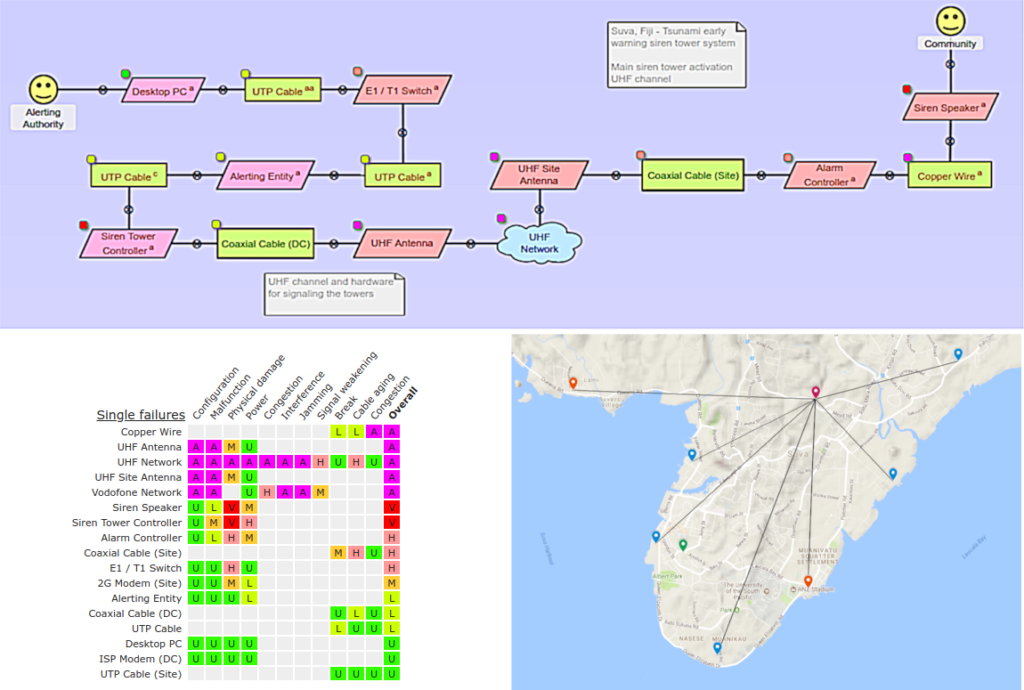The ESCAP Asia Pacific Information Superhighway (AP-IS) steering committee meeting, this past August in Bangkok, heard us present the need for an inventory of E-Resilience tools. Among the list of recommended concepts was the Risk Assessment and Step-wise Refinement (RASTER) methodology; one that caught ESCAP’s attention. The tool and its participatory approach reveal “black swans“, in telecommunications, to then derive policies and procedures for mitigating those low-frequency high impact vulnerabilities.
Having realized the utility, ESCAP invited us to introduce the RASTER method to participants of the Subregional workshop on the implementation of the AP-IS and SDGs in Pacific Islands (19-23 Aug 2018, Nadi, Fiji). The participants went through a half day session, designed to introduce case studies, theory, tools, and methods on E-Resilience. We confined the scope to emergency communication (or disaster communication). Within that scope we exercised three activities:
- Sharing participant experiences of telecom outages during disasters.
- Trialing a questionnaire designed to realize the necessary components of a working and effective Business Contingency Plan (BCP)
- Hands-on with the RASTER tool
All three activities converged on realizing and understanding how to use simple tools in achieving E-Resilience.

RASTER diagram with analysis of the UHF-based siren triggering system; the vulnerability analysis table; and the map of siren towers in the updated Suva-Fiji Tsunami siren warning system
For part of the RASTER Exercise, we used a real-world case of the updated Suva-Fiji Tsunami siren warning system. The diagram shows the UHF-based siren triggering system and the respective RASTER analysis. Through the RASTER exercises, the participants found that signal weakness, physical damage to hardware & wires, and stable main-grid and adequate battery power were the significant shortcomings. It is important that E-Resilience consider a systems approach; where power systems, for example, are imperative. It requires considering all stakeholders and dependencies as well. Moreover, investigating the damage, congestion, and jamming type factors affecting single and common component failures.
The participants trialed the questionnaire designed to assist in realizing the business continuity readiness. One would typically exercise this questionnaire with the depended Telecos or their own institutions, for example. The “cloud” component, in RASTER, is used when there is ambiguity in the actual internal mechanics of a system. It could be a UHF relay network, as in the example of remotely triggering the siren towers. The business contingency readiness questionnaire becomes resourceful in understanding the reliability of this cloud service and prevailing Black Swans.
What we learned from the unofficial results of the experimental exercise conducted with members of ICT apex and Regulatory bodies is that:

Scale -1.00 = Unaware of, 0.00 = No, don’t have, 1.00 = Work in Progress, & 2.00 = Yes, they have – tested emergency recovery procedures.
- Samoa and the Solomon Islands claim to have well-established BCP requirements with trained personnel, institutionalized procedures and having identified all communication priorities and components.
- All other member state institutions have management procedures, but they fall short in implementing the necessary elements for making their communication resilient.
- A key element is that none of them, except for the Solomon Islands, have fully tested telecom emergency recovery procedures.
- Only Solomon Islands, Tonga, and Tuvalu have established mechanisms to be aware of threats and relay those to the response teams for activating any kind of response procedures. The others either have partial or no mechanism to alert of events or threats.
The evidence of their readiness can be matched with the Participant stories – 2015 Cyclone Pam was a common experience and a point of reference, for most of them. The category 5 cyclone plowed through Vanuatu, with 200km/h winds, damaging all their telecoms. It also affected their neighbors. Although the cyclone path maps show it to die north of Vanuatu, the effects reached as far as the southern outer islands of Kiribati, close to Tuvalu. The strong ttsunami-likewaves damaged their only Speedcast VSAT link but now replaced with a Kasific link.
Most outer islands, of all Pacific Islands, are shy of 3GPP-based internet. The small populations makes it difficult for the Islands to build a lucrative business case to lure investors. The economic struggles, Small Island Developing States face, makes it difficult for them to subsidize the role out. To compensate, VHF radios are the only mode to stay connected with Island Councils.

Group Photo of participants at the UNESCAP AP-IS Subregional meeting for the Pacific, in Nadi, Fiji, 19-20 November 2018


Comments are closed.